Perfect Roasted Acorn Squash is so easy to make! Buttery, tender, and sweet, it’s the best side dish for the cooler fall and winter months.
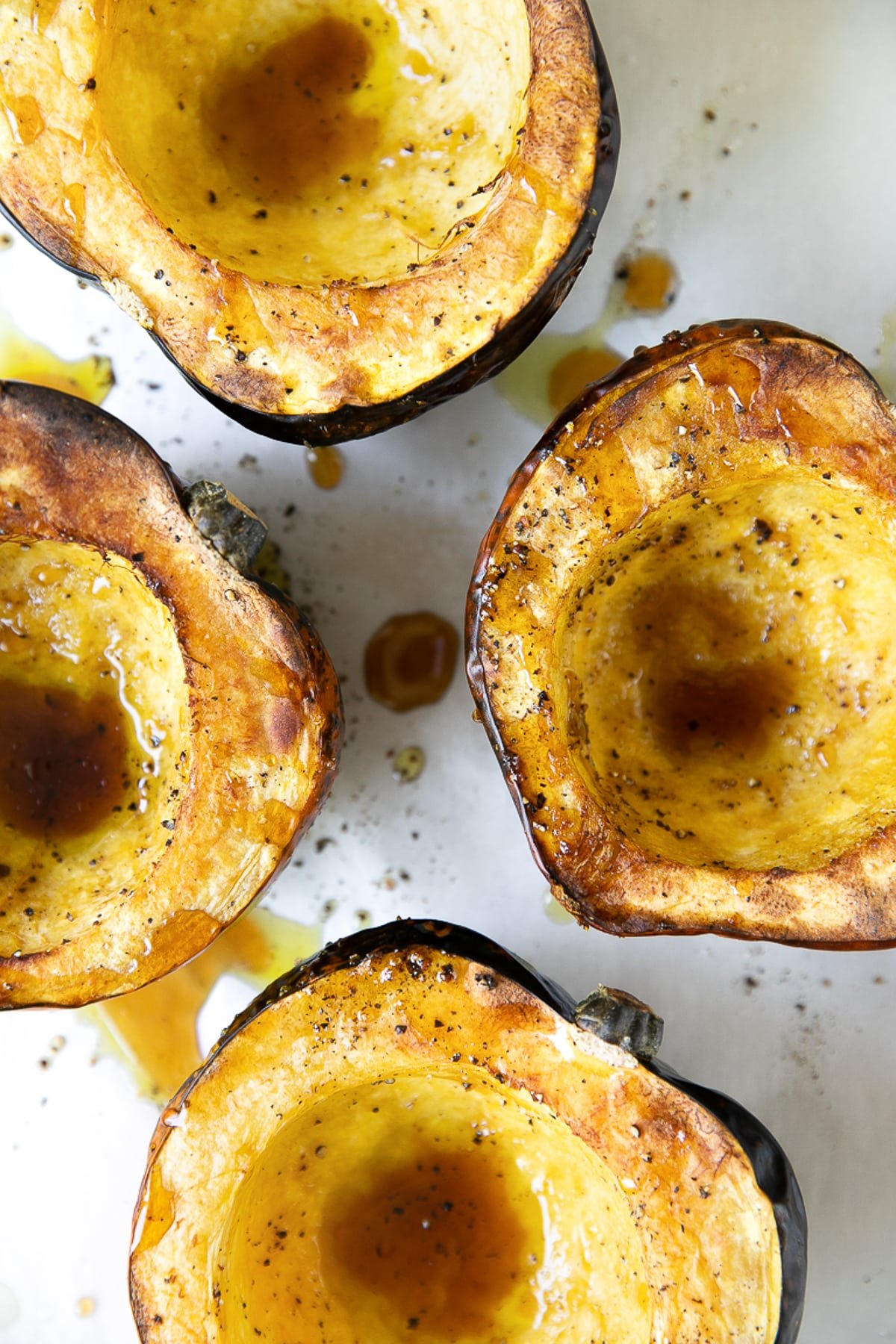
Perfect Roasted Acorn Squash
I love acorn squash. They’re naturally sweet, love to be stuffed, and taste fantastic whether you roast them in halves or in slices. The skin is edible, so peeling isn’t required, and they last forever (2-3 months) when stored in a cool and dry place.
If you’re new to acorn squash, then you’re in the right place. Here you’ll learn everything you need to know from picking acorn squash to cutting them open, roasting them in the oven, and their stand-out nutritional information.
What is Acorn Squash
Acorn squash (Cucurbita pepo), while typically considered a winter squash, is part of the same species as summer squash (zucchini and crookneck squash, for example). Indigenous to North and Central America, it produces yellow trumpet-looking flowers that are edible.
Acorn squash is the most nutrient-dense of all summer squash. They are,
- A great source of vitamin C which helps boost immunity
- High in fiber (2.1 grams per 1 cup).
- High in potassium (486 mg per 1 cup).
Highly versatile, this formidable-looking squash tastes delicious in a variety of different recipes and can be roasted, toasted, sautéed, pureed, mashed, stuffed, or used in baked goods like muffins and bread.

How to Roast Acorn Squash
First, start by preheating your oven to 400 degrees F and lining a large baking sheet or sheet pan with parchment paper. Wash the acorn squash under cold running water and dry thoroughly.
Use a sharp knife, and cut your squash in half from stem to tip. If it is a struggle, don’t try to cut the stem in half. Cut around it. Then use a metal spoon to scoop and scrape out the seeds and stringy bits from the inside of each squash until smooth.
Place the squash halves cut-side-up on your prepared baking sheet or sheet pan.
Drizzle the top of the acorn squash halves with olive oil or avocado oil and use a pastry brush to evenly coat the entire surface. Sprinkle with salt and pepper and drizzle with 1-2 tablespoons maple syrup or brown sugar, if desired.
Roast uncovered (flesh side up) for approximately 45-60 minutes or until tops are nice and golden brown and the squash flesh is soft and cooked through.
- Note: It is better to slightly overcook the squash than undercook it, so if you are unsure if it’s cooked, add more time.
When done, remove from the oven and allow time to cool before serving.
When I’m in the mood for something sweet, I like to top mine with a little melted butter, salt, and a sprinkle of brown sugar. For a more savory option, sometimes I’ll drizzle with melted butter and sprinkle with grated parmesan cheese, garlic powder, salt, and black pepper.
What Makes Roasted Acorn Squash Taste So Good?
The most common (and flavorful) way to cook acorn squash is in the oven. The reason for this delightful flavor boost is that the dry heat from the oven caramelizes the natural sugars in the acorn squash (or any veggie) bringing out their naturally sweet, nutty, and complex flavor.
The same reasoning applies to roasted asparagus, butternut squash, cauliflower, and even chicken.

How to Pick an Acorn Squash
1. An equal balance of green and orange coloring is a good indication that the squash is neither too ripe nor not ripe enough.
- Mostly orange – likely over-ripe and will have too many orange stringy bits.
- Mostly green – probably not ripe enough and will lack the delicious squash flavor we’re seeking
2. Pick a squash that is heavy for its size. Not the biggest and therefore heaviest squash, but the heaviest squash for its size.
3. Dull is better than shiny. In the case of squash, duller skin wins over shiny skin. That said, the skin should be smooth without any wrinkling or soft spots.

How to Cut an Acorn Squash
You may approach cutting it one of two ways-
- Slice 1/4-inch of the stem end and base end of the squash. You will not lose much, if any, of the squash interior by using this method. However, it will create a stable base for you to stand up the squash allowing you to chop it in half vertically. I prefer this method if I am not planning on baking and stuffing.
- In this second method, you’ll be cutting the squash right in half from top to bottom (as shown in these images). To do this without cutting off your finger, find a valley in between one of the ridges – ideally, the ridge should be just to the side of the stem as you DO NOT want to try to cut through the stem.
In either case, once you make that initial entry point, use that as your guide. Drive the knife through your squash and continue by cutting around the entire squash. If the knife gets stuck, return to the starting point and rotate in the opposite direction.
Can You Eat Acorn Squash Skin?
Yes, you can absolutely eat the skin of cooked and roasted acorn squash. After roasting, the outer skin will be tender, delicious, and nutritious.

Is Baked Acorn Squash Healthy?
Yes, definitely.
- It is more nutrient-dense than all other types of summer squash.
- Contains significant levels of vitamin C, vitamin A, Potassium, pantothenic acid, thiamin, and other B-vitamins
- High levels of minerals like magnesium, manganese, iron, copper, phosphorous, and calcium.
More Roasted Squash Recipes,
If you love this acorn squash recipe, try one of these other easy roasted squash recipes next!
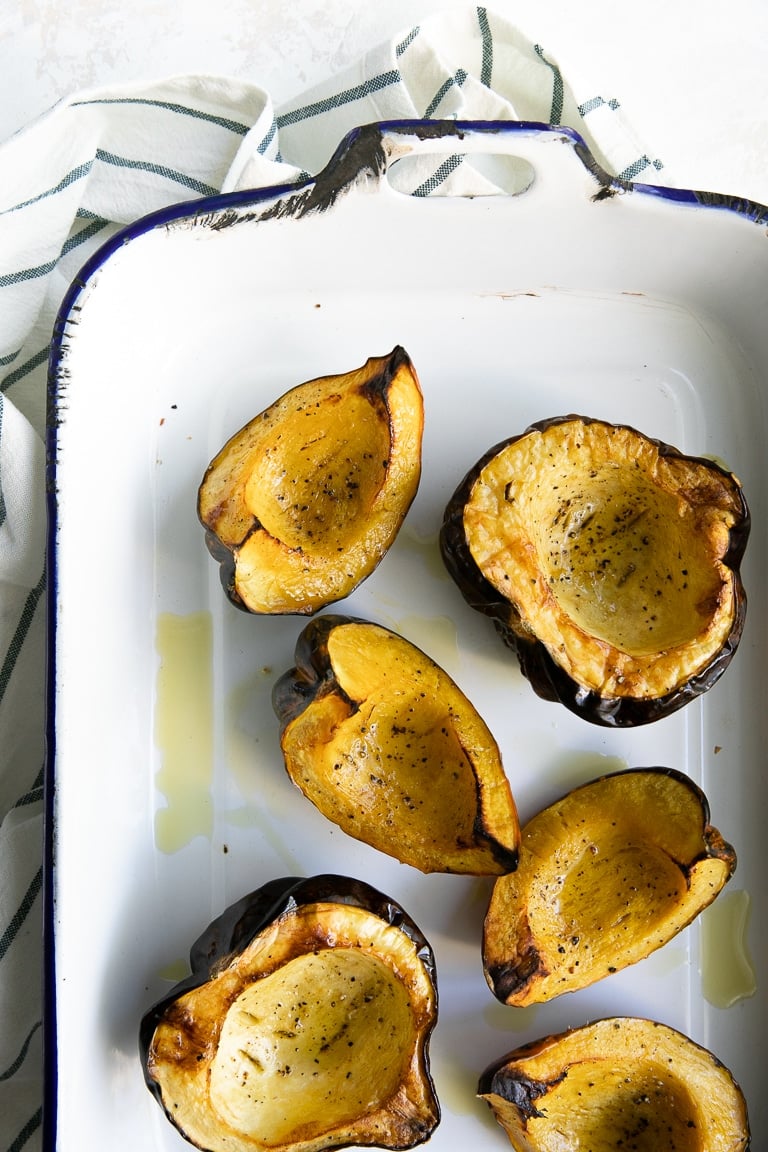
Have you tried this Roasted Acorn Squash Recipe?
Tell me about it in the comments below! I always love to hear your thoughts. And tag me #theforkedspoon on Instagram if you’ve made any of my recipes, I always love to see what you’re cooking in the kitchen.
RECIPE CARD
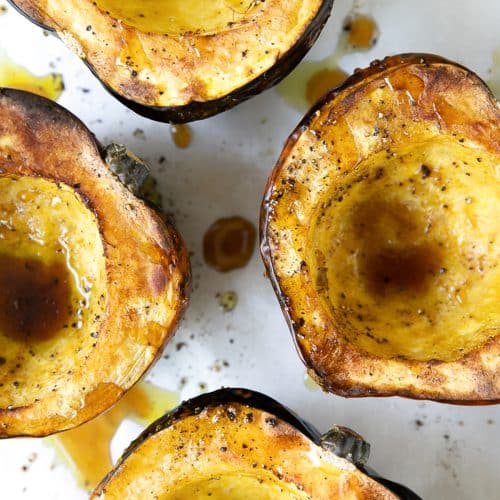
Roasted Acorn Squash
Ingredients
- 1 acorn squash
- 1 tablespoon olive oil - divided
- salt + pepper - to taste
- maple syrup or brown sugar - optional
Instructions
- Preheat oven to 400 degrees F.
- Using a sharp, sturdy chef’s knife, cut the acorn squash in half from stem to tip. If it is a struggle, don’t try to cut the stem in half. Cut around it.
- Using a metal spoon, scoop and scrape out the seeds and stringy bits from the inside of the squash until it is smooth.
- Place the squash halves cut-side-up in a roasting pan (I used a jelly roll pan).
- Drizzle top side of your squash with olive oil. Use a pastry brush to evenly coat the entire surface. Sprinkle with salt and pepper.
- Bake for approximately 45-60 minutes or until tops are nice and golden brown and the squash flesh is soft and cooked through. It is better to slightly overcook your squash than undercook it, so if you are unsure if it's cooked, add more time. When done, remove from the oven and allow time to cool before serving.
Jessica’s Notes
- Can you eat the skin? Yes.
- To make the squash taste a little sweeter, sprinkle it with brown sugar or drizzle it with maple syrup.
- As written, this recipe is naturally vegan, gluten-free, and vegetarian.
Nutritional Information
(Nutrition information provided is an estimate and will vary based on cooking methods and specific brands of ingredients used.)

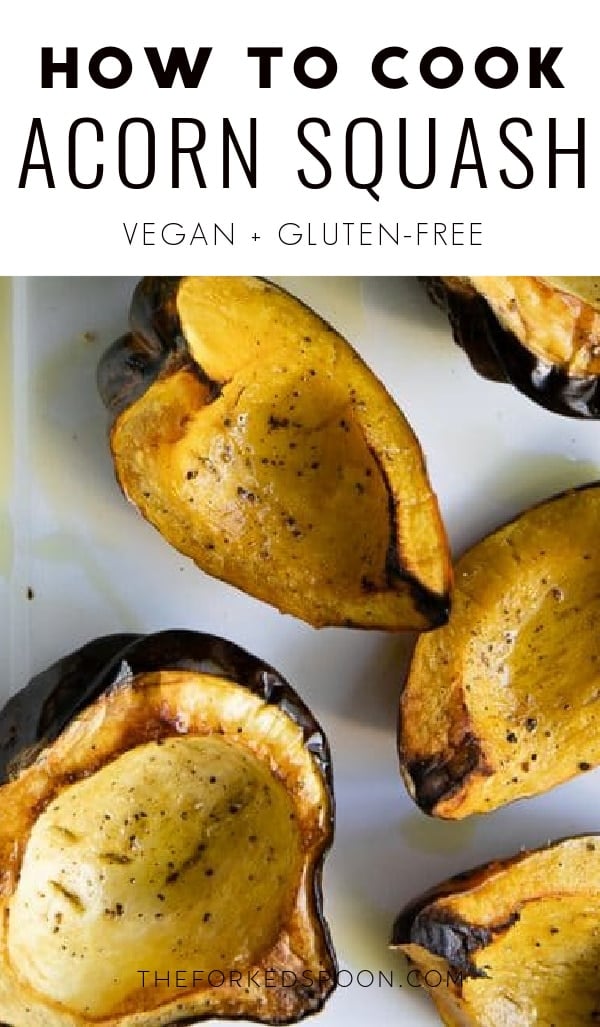
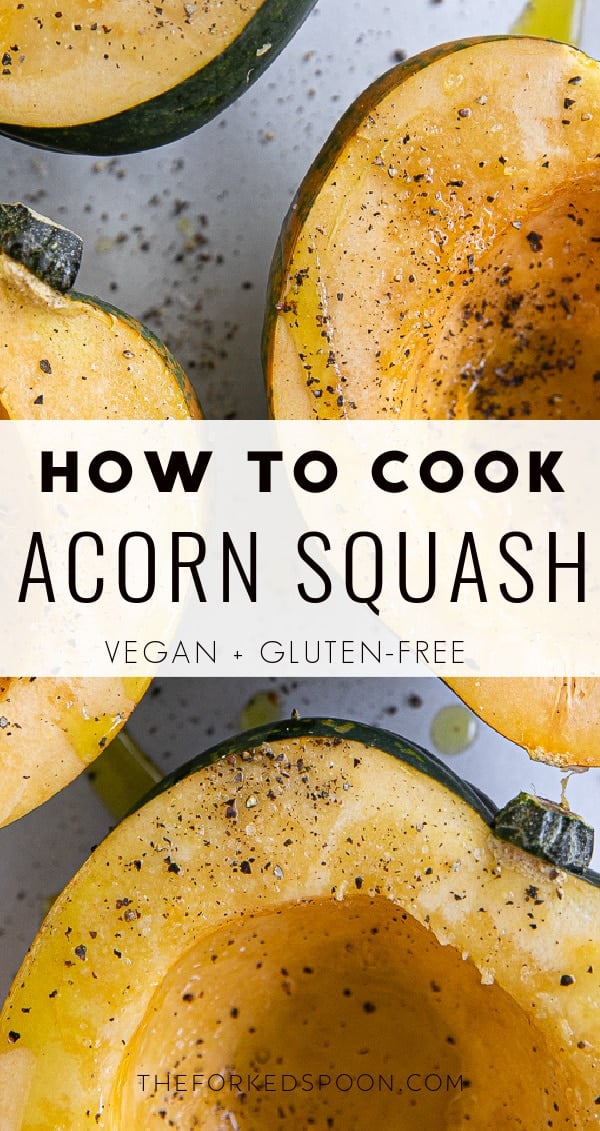



Doesn’t tell you what to do with the maple syrup
Please see the notes at the bottom of the recipe card for the optional maple syrup:
”
To make the squash taste a little sweeter, sprinkle it with brown sugar or drizzle it with maple syrup.
”
🙂
Just a small tip to share: I was always frustrated trying to remove the seeds and stringy inside of the acorn squash. Someone recommended using a melon baller. It works better than anything else I have tried.
Brusһ ttop of the foil witһ further virgin olive oil.
I love roasting acorn squash and then folding into quick-cooking polenta to add nutrients and change up the flavor of the polenta – I frequently add sage. I serve it with roasted chicken thighs and sometimes chopped pistachios.
Hi Francesca,
I will have to try it with chopped pistachios 🙂 , sounds yummy!
this was just what I was searching for!
Love reading cooking tips and seeing different techniques! Thanks for sharing!
I love acorn squash. Tastes so good roasted. I know some who like it with a little smear of butter, cinnamon, sugar etc. Nice instructions too!
Yum! I love squash season! I could eat it every night!
Yum, I just love acorn squash and roasting has to be the best way to cook it, a really intensely sweet flavour. Thanks for the instructions – this will make a lovely autumnal supper soon.
I look forward to this time of year just so I can eat acorn squash. thanks for all the helpful cooking tips!
This was so simple and yummy – thank you!
Cooking time was less for me but I think that’s because I had the oven on convection setting, plus my squash was on the small side. I too was trying to familiarize myself with it better as an ingredient as I’ve only ever had it baked with butter/sugar/cinnamon. It was interesting to try it simply from a savory aspect. I’m more comfortable now with making it and trying different applications. Thanks!
I made this last night, my husband and I LOVED it. Thanks for the recipe…